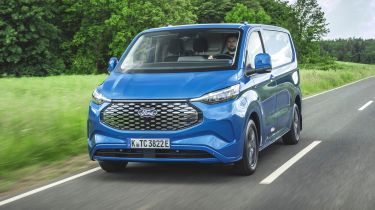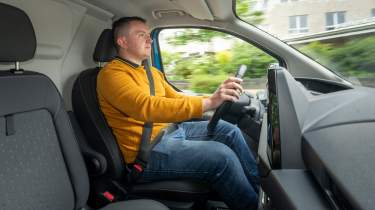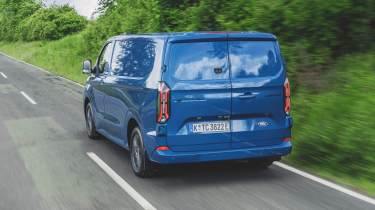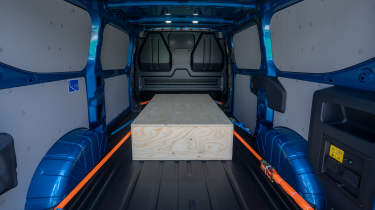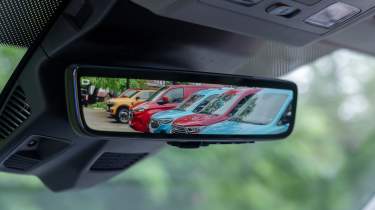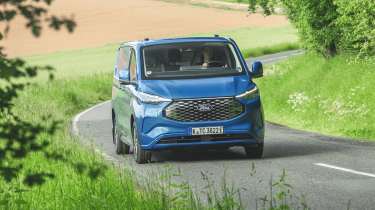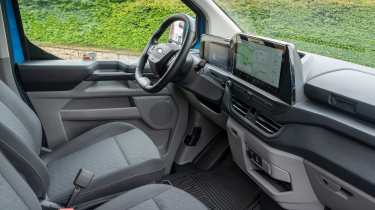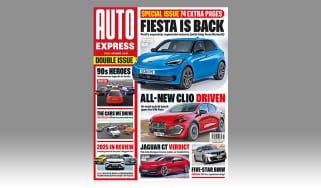Ford E-Transit Custom review
Ford’s best-seller is finally available as an electric van, and it’s a very convincing one at that
Ford has played things rather safe with the electric e-Transit Custom. Don’t be too disappointed, though, as this is actually a good thing. After all, the combustion model with which this EV shares its DNA is one of the brand’s best-sellers for some very good reasons.
Just like its piston-powered sibling, the fully-electric Custom is surprisingly good to drive and even the least-powerful variant is more than capable of spirited overtaking manoeuvres and motorway driving. When it comes down to the most crucial aspects, there’s decent battery range across the lineup while cargo and passenger space can be found in abundance, too.
About the Ford E-Transit Custom
It’s a big deal for pretty much any vehicle to launch in pure-electric form, but particularly so for the Transit Custom which is one of Ford’s biggest-sellers in the UK - not just within the van division, but for the entire brand. The full-sized Ford E-Transit has been with us since 2022, and now Ford is hoping that its medium-sized sibling, the Ford E-Transit Custom, will tempt an enormous number of existing customers away from diesel while bringing plenty of new ones into the Blue Oval fold.
The Transit Custom’s lineage is a strong one, but the electric van market is already a competitive sector that’s continuing to expand at a steady rate. The E-Transit Custom’s rivals in the mid-size electric van segment include the likes of the Vauxhall Vivaro Electric, Citroen e-Dispatch, Fiat E-Scudo, Peugeot e-Expert, Renault Trafic E-Tech, Mercedes eVito and Maxus eDeliver 7. That’s already a big list, and it only grows when you consider the electric Ford’s traditionally -fuelled rivals, chief of which is its very own sibling, the regular Transit Custom.
Used - available now
The pressure is close to bursting-point, then, but Ford has stuck to its winning formula. Take one look at the Ford E-Transit Custom and you’ll notice it doesn’t really look that much different to the combustion version. In fact, you’ll have to look closely to notice some of the giveaways, namely the charging port, ‘E’ badging and, of course, the lack of exhaust pipes.
Ford has definitely taken the ‘if it ain’t broke, don’t fix it’ approach by following the same proven basic formula as the regular Custom. The big change is the one you can't readily see, the fully-electric powertrain.
This sense of familiarity should appeal, too, as we have no major qualms about the quality or kit that the Ford Transit Custom offers. Make no mistake, this is still a rather bulky vehicle and you’ll always be aware of that fact when behind the wheel, but the E-Transit Custom is still reasonably car-like to drive for its size. There’s a noticeable amount of punch when you plant your right foot, the ride is pleasingly refined for the most part and there’s a generous helping of tech, too.
Speaking of technology, venture underneath the E-Transit Custom and you’ll find one of three powertrain setups, depending on your chosen spec, and each one is based on the same 64kWh battery pack which offer 209 miles of range on the WLTP combined cycle.
Doing away with diesel does mean a slight sacrifice in terms of payload, though. The E-Transit Custom can carry up to 1,088kg in standard panel van form, compared to 1,327kg for the regular Transit Custom.
Kicking off the line-up is the Trend trim, which is powered by a 134bhp rear-mounted motor and fitted with standard kit including a 13-inch touchscreen with Ford’s SYNC 4 software, a rear-view camera, automatic air-conditioning and Ford’s Pro Power Onboard system, which allows the van to double up as 2.3kW generator for items such as power tools or lighting.
Next up is the Limited trim which gives the E-Transit a slightly smarter look by adding 16-inch alloy wheels. It also includes useful extras like electronically-adjustable heated seats, LED lighting and Ford’s Parking Pack. If you like your van with a bit of sporting flavour, the aptly-named Sport trim may suit. Along with exterior tweaks including stripes and larger alloy wheels, this version backs up its faster appearance with a larger 215bhp motor.
If that still isn’t hot enough for you, at the top of the range sits the rather bonkers MS-RT. This ups the power even further to 282bhp and chucks on a very lairy additional bodykit and conspicuous paint options such as Yellow Green, MS-RT Blue or Cadmium Yellow.
There’s even more choice when it comes to sizes and body styles. The Ford E-Transit can be specced as a regular panel van, a double-cab with six passenger seats, a Kombi with up to eight seats or a Multicab with a two-seat second row and L-shaped bulkhead. There are also two wheelbases to choose from: the standard length L1 or extended L2. The only thing that can’t be changed is the height, as the e-Transit Custom can only be specced in the 1,968mm tall H1 roof height.
Efficiency, range and running costs
Each version of Ford’s mid-size electric van is powered by the same 64kWh battery, and this has a claimed maximum range of 209 miles on the WLTP combined cycle. While this does make the E-Transit Custom suitable for longer motorway trips, it fails to lead the class. The Vauxhall Vivaro Electric can cover up to 219 miles between top-ups, while Maxus claims up to 230 miles for the eDeliver 7.
When it’s time to plug in, the charging port is located at the front so it doesn’t impede access to the van. Peak DC rapid charging capacity sits at 125kW, which means a 10-80 per cent top-up takes around 39 minutes. A full charge from a 7.4kW home wallbox charger should take around eight and a half hours.
While charging at home is considerably cheaper than filling up with diesel, opting for the electric Transit also means you’ll avoid VED road tax until April 2025, along with emissions-based charges such as the London Ultra Low Emission Zone (ULEZ). The E-Transit Custom is also eligible for the Government’s plug-in van grant (PIVG) until March 2025.
Pricing for the Ford E-Transit Custom starts from around £45,000 (excluding VAT) for the L1H1 variant in base Trend trim, while the larger L2H1 carries a premium of around £600. The more powerful Sport variant pushes the electric Custom over the £50,000 threshold, while the range-topping MS-RT will set you back by around £62,000. In comparison, pricing for the diesel Transit Custom starts from around £34,200.
Ford offers a three-year/unlimited-mileage warranty with the E-Transit Custom, and it recommends that servicing is carried out every two years regardless of mileage.
Load space and practicality
The E-Transit Custom provides the same amount of load volume as its combustion counterparts. The short wheelbase L1 offers 5.8 cubic metres of space, and this increases to 6.8 cubic metres for the extended L2. There’s 1,932mm of space between the wheel arches on both variants, and the rear doors open up to 90- or 180-degrees to reveal a 1,400mm wide opening. If you’re entering from the side, a hands-free power-assisted sliding door is included as standard with the Limited, Sport and MS-RT trims.
There is, however, a penalty to pay when it comes to maximum payload. The EV can’t carry as much weight as the diesel van and payload capacities decrease as you work your way upwards through the line-up. The E-Transit Custom’s highest payload capacity sits at 1,088kg, but this is only in the Trend variant. Moving up to the Limited spec drops this figure slightly to 1,066kg, the Sport drops further still to 1,054kg, while the top-spec MS-RT can only handle 1,036kg. In comparison, the diesel Custom offers up to 1,384kg of payload capacity but also dips as low as 891kg in the less-powerful models.
The electric Custom’s flat floor means there’s a bit more space up front in the cab area, which makes it easy to move around the cabin and you can store a bit of additional cargo if you need to. Opting for Ford’s load-thru bulkhead means you can feed longer items through from the cargo area, too.
If you’ve filled the E-Transit Custom to the brim and need to bring a trailer, every version has a braked towing capacity of 2,300kg, which makes it one of the most capable electric vehicles for towing duties.
Reliability and safety
The standard Ford Transit Custom is already proving itself as a dependable workhorse, and given that electric vans have fewer mechanical components, we’d expect the E-Transit Custom to be just as reliable, if not more so.
Euro NCAP has awarded the Custom with its coveted platinum medal for commercial van safety, and this comes as little surprise when you look at the sheer level of safety tech that comes as standard. Even base Trend trim models get pre-collision assist, adaptive cruise control, lane-keeping assist, road sign recognition, wrong way alert, a reversing camera and front and rear sensors as standard.
On the move, these systems are supportive rather than intrusive, particularly the lane-keeping assist. The speed-limit detection system is also quick to chime at you if you’re straying over the limit, which can become a bit annoying. If you prefer to drive without assistance, most of these functions can be switched off via a steering-wheel mounted button or the touchscreen.
An electronic rear-view camera is added in place of a traditional mirror, and this takes the guesswork out of figuring out if there’s someone behind you, not to mention reversing. If you’re not too keen on tech, the doors are still fitted with traditional two-piece mirrors for monitoring the side of the van and its blind spots. Visibility is decent overall, but we did have to lean forward at some trickier junctions.
In order to deter thieves, Ford offers a remote monitoring service where owners or fleet managers can be alerted of vehicle defects and security alerts in real time. Upgraded door locks are also available.
Driving and performance
Long gone are the days of the noisy and sluggish Transit van. The diesel Transit Custom was already one of the more refined offerings in the medium van class, not to mention one of the best to drive, and electric power only goes to improve things even further.
The Ford E-Transit Custom does an admirable job of remaining composed for its size, the extra ballast of the battery possibly helping here. Even at slower speeds, the ride remains mostly bounce and crash-free, with only the biggest road imperfections causing any real upset to the ride quality. Even when this does occur, it’s only for a brief moment.
It’s a similar story when it comes to noise, too, as wind and tyre roar are kept well under control all the way up to motorway cruising speeds. There is a noticeably loud whine from the rear-mounted electric motor, though, particularly when setting off and coming to a stop.
If you can tolerate the noise, the electric motor provides a healthy dose of acceleration even in its least-powerful form. The Trend and Limited versions churn out 134bhp, while the Sport ups this figure to 214bhp. Both produce the same 415Nm of torque, hence the strong initial punch when you plant the right pedal regardless of which version you’re in. Our test van was a 160kW Sport model, and even managed to hold its own on a section of derestricted German Autobahn while remaining reasonably refined.
If you really want the most performance out of your E-Transit Custom, there’s always the option of the 282bhp MS-RT, along with the same 415Nm of torque. This version is indeed a bit quicker than the 215bhp Sport, but it’s difficult to see the advantage of shelling out nearly £12,000 more unless you desperately want the brighter paint and bold exterior add-ons.
In town, the E-Transit Custom’s steering and throttle are easy to manage and shouldn’t prove very intimidating for a van-driving newbie. However, the brakes aren’t quite as responsive as we’d have hoped, and there is a bit of a mushy feel to the pedal. Using the auto-hold function also results in an unceremonious shunt every time you set off.
On the plus side, the transition between regenerative and mechanical braking is pretty smooth, while the regen itself is reasonably strong without being overbearing. There’s also the option of one-pedal driving.
Cab and interior
Step inside the E-Transit Custom and the sense of familiarity continues. The dashboard features the same twin-screen setup as the combustion models, with a 13-inch SYNC 4 infotainment system at the centre. This system is responsive to the touch but it does look a little bit bland compared to some rivals. If you prefer, Apple CarPlay and Android Auto are included as standard.
The physical controls remain the same, too. The gear selector is a simple steering column stalk, while the electronic parking brake switch is located between the centre air vents. This means there’s no floor-mounted controls whatsoever, which makes it far easier to move around the cabin.
While there are some physical buttons for functions like the heated windscreen, these are all stamped onto a single strip of plastic so they aren’t very ergonomic. Unless you have particularly good muscle memory, you will still need to look away from the road ahead to find the switch you want. Unfortunately, you’ll also need to venture onto the infotainment system to access the climate controls, although there are some shortcuts at the bottom of the screen.
One feature that may catch your eye is the unusual oblong-shaped steering wheel. This may remind some classic car enthusiasts of the Austin Allegro but there is some method to Ford’s apparent madness here. Opt for the optional Mobile Office pack and this wheel can be tilted for use as a tablet stand or even a lunch tray. There’s a plastic topper that slots onto the wheel should you wish to eat your meal on the go, which saves having to carry your own tray or eat off your own lap. The downside is that the wheel does feel a bit strange when you actually need it for steering.
If you’re covering mega miles, the seats are adequate but not the most comfortable we’ve tried. The backrests are rather thin and there’s little lumbar support. Opt for Limited trim or above and you’ll get heated seats, while the Sport and MS-RT get electronic driver’s seat adjustment, too.
| Van dimensions | |||
| Body style | Height | Width | Length |
| SWB low roof (L1H1) van | 1,968mm | 2,032mm (2,275mm inc mirrors) | 5,050mm |
| LWB low roof (L2H1) van | 1,966mm | 2,032mm (2,275mm inc mirrors) | 5,450mm |
| Load area dimensions | ||||
| Body style | Height | Width | Length | Volume |
| SWB low roof (L1H1) van | 1,322mm | 1,392-1,777mm | 2,602mm | 5.8m3 |
| LWB low roof (L2H1) van | 1,822mm | 1,392-1,777mm | 3,002mm | 6.8m3 |

